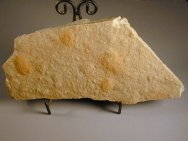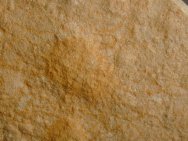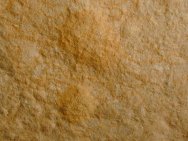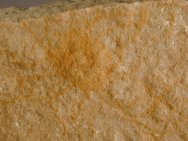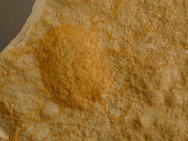Jellyfish Fossils
Phylum Cnidaria, Class Scyphozoa, undescribed jellyfish
Geologic Time: Upper Cambrian (about 510 million years ago)
Size (25.4 mm=1 inch): Matrix: about 12.5 by 5.8 inches
Fossil Site: Krukowski Quarry, Elk Mound Group, Mount Simon Sandstone, near Mosinee, Wisconsin
Code: DD430
Price: $275.00 - sold
|
Two general types of jellies are found in the quarry as mass strandinds: 1) large medusoid forms of class Scyphozoa measuring up to 50 cm, far and away the largest jellyfish in the entire fossil record, and 2) smaller forms, of 25 to 75 mm Scyphozoa. The smaller jellyfish body fossils shown here are subtle with usually slight relief, and therefore this specimen has been subtly stained; the tentacles are the result of artistic license since very few of the fossils have exhibited relief that could be unequivocally attributed to tentacles. The large medusae fossil jellyfish have been described by Hagadorn (2002), but the description of the small jellyfish remains pending. Being
comprised entirely of soft tissue (living jellyfish are about 95
% water), unlike animals with exoskeletons (e.g., trilobites) or
skeletons (vertebrates), jellyfish fossils are body fossils that
are impressions of the jellyfish. Such fossil impressions are rare
throughout the fossil record. During the Cambrian, there were no
land Phylum Cnidaria (anemones, corals, jellyfish and sea pens) are among the most ancient animals and has one of the longest fossil histories of metazoans. Though simple in body form, they remain ubiquitous and widespread in modern marine environments. The earliest forms in the fossil record appear in the Ediacarian fauna of Southern Australia, which dates to the Precambrian some 600 million years ago. Their persistence is clear testament that old and simple animals can be enormously successful, and that the clique' "climbing the evolutionary ladder" is a misnomer; rather, life either adapts to the current and changing environment, or perishes. Jellyfish may have been one of the most ferocious predators of the Cambrian marine environment. Also see: Cambrian Shadows Reference: Hagadorn, JW., Dott, RH., Damrow, D, Stranded on a Late Cambrian shoreline: Medusae from central Wisconsin, Geology (39) No. 2. |
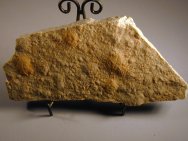
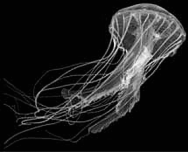 based predators. Once washed ashore, the jellyfish likely pumped
sand to form the relief seen in these fossils. Bacterial mats or
rapid burial may have assisted in the preservation by mitigating
erosion or bioturbation.
based predators. Once washed ashore, the jellyfish likely pumped
sand to form the relief seen in these fossils. Bacterial mats or
rapid burial may have assisted in the preservation by mitigating
erosion or bioturbation.